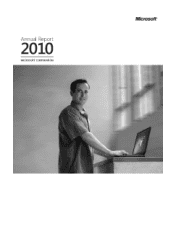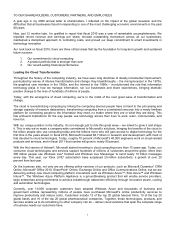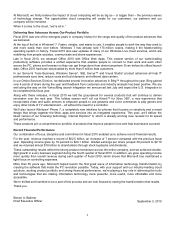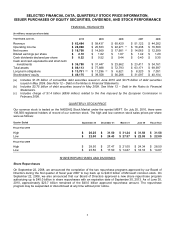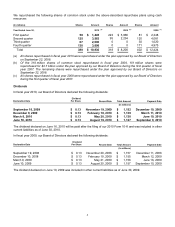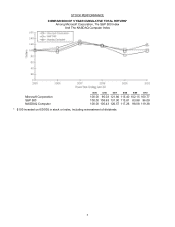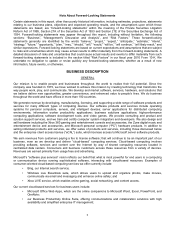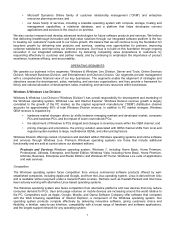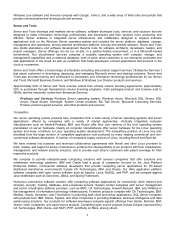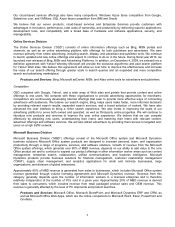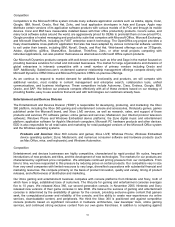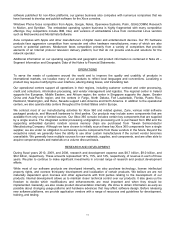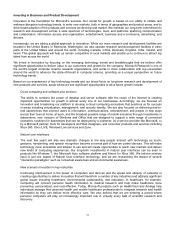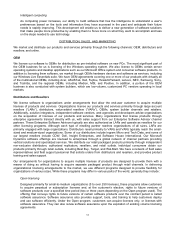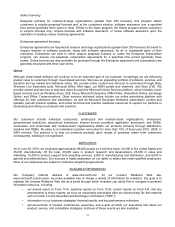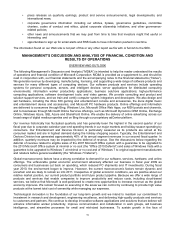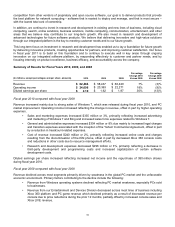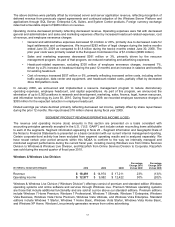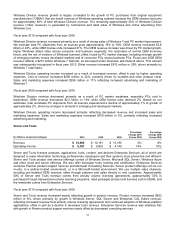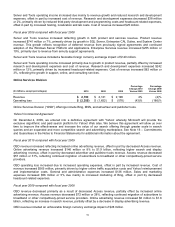Microsoft 2010 Annual Report Download - page 11
Download and view the complete annual report
Please find page 11 of the 2010 Microsoft annual report below. You can navigate through the pages in the report by either clicking on the pages listed below, or by using the keyword search tool below to find specific information within the annual report.10
Competition
Competitors to the Microsoft Office system include many software application vendors such as Adobe, Apple, Corel,
Google, IBM, Novell, Oracle, Red Hat, Zoho, and local application developers in Asia and Europe. Apple may
distribute certain versions of its application software products with various models of its PCs and through its mobile
devices. Corel and IBM have measurable installed bases with their office productivity products. Corel’s suites, and
many local software suites around the world, are aggressively priced for OEMs to preinstall them on low-priced PCs.
Google provides a hosted messaging and productivity suite that competes with Microsoft Office, Microsoft Exchange,
and Microsoft SharePoint, including its FAST enterprise search technology. The OpenOffice.org project provides a
freely downloadable cross-platform application that also has been adapted by various commercial software vendors
to sell under their brands, including IBM, Novell, Oracle, and Red Hat. Web-based offerings such as 37Signals,
Adobe, AjaxWrite, gOffice, ShareOffice, Socialtext, ThinkFree, Zoho, or other small projects competing with
individual applications, can also position themselves as alternatives to Microsoft Office system products.
Our Microsoft Dynamics products compete with well-known vendors such as Infor and Sage in the market focused on
providing business solutions for small and mid-sized businesses. The market for large organizations and divisions of
global enterprises is intensely competitive with a small number of primary vendors including Oracle and
SAP. Additionally, Salesforce.com’s on-demand customer relationship management offerings compete directly with
Microsoft Dynamics CRM Online and Microsoft Dynamics CRM’s on-premise offerings.
As we continue to respond to market demand for additional functionality and products, we will compete with
additional vendors, most notably in content management and enterprise search, collaboration tools, unified
communications, and business intelligence. These competitors include Autonomy, Cisco, Endeca, Google, IBM,
Oracle, and SAP. We believe our products compete effectively with all of these vendors based on our strategy of
providing flexible, easy to use solutions that work well with technologies our customers already have.
Entertainment and Devices Division
The Entertainment and Devices Division (“EDD”) is responsible for developing, producing, and marketing: the Xbox
360 platform, including the Xbox 360 gaming and entertainment console and accessories, third-party games, games
published under the Microsoft brand, and Xbox LIVE services, as well as research, sales, and support of those
products and services; PC software games; online games and services; Mediaroom (our Internet protocol television
software); Windows Phone and Windows Embedded device platforms; the Zune digital music and entertainment
platform; application software for Apple’s Macintosh computers, Microsoft PC hardware products and other devices.
EDD is also responsible for all retail sales and marketing for retail packaged versions of the Microsoft Office system
and the Windows operating systems.
Products and Services: Xbox 360 console and games; Xbox LIVE; Windows Phone; Windows Embedded
device operating system; Zune; Mediaroom; and numerous consumer software and hardware products (such
as Mac Office, mice, and keyboards); and Windows Automotive.
Competition
Entertainment and devices businesses are highly competitive, characterized by rapid product life cycles, frequent
introductions of new products and titles, and the development of new technologies. The markets for our products are
characterized by significant price competition. We anticipate continued pricing pressure from our competitors. From
time to time, we have responded to this pressure by reducing prices on certain products. Our competitors vary in size
from very small companies with limited resources to very large, diversified corporations with substantial financial and
marketing resources. We compete primarily on the basis of product innovation, quality and variety, timing of product
releases, and effectiveness of distribution and marketing.
Our Xbox gaming and entertainment business competes with console platforms from Nintendo and Sony, both of
which have a large, established base of customers. The lifecycle for gaming and entertainment consoles averages
five to 10 years. We released Xbox 360, our second generation console, in November 2005. Nintendo and Sony
released new versions of their game consoles in late 2006. We believe the success of gaming and entertainment
consoles is determined by the availability of games for the console, providing exclusive game content that gamers
seek, the computational power and reliability of the console, and the ability to create new experiences via online
services, downloadable content, and peripherals. We think the Xbox 360 is positioned well against competitive
console products based on significant innovation in hardware architecture, new developer tools, online gaming
services, and continued strong exclusive content from our own game franchises. In addition to competing against

